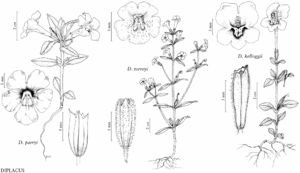Diplacus torreyi
Phytoneuron 2012-39: 32. 2012.
Herbs, annual, herbage not drying dark. Stems erect, (20–)40–380(–530) mm, glandular-puberulent to glandular-pubescent. Leaves usually cauline, gradually reduced distally; petiole poorly delimited; blade elliptic or oblanceolate, (3–)6–40(–48) × (0.5–)1–14(–19) mm, margins entire, plane, apex rounded, surfaces: proximals glabrate, distals glandular-puberulent or glandular-pubescent. Pedicels 1–3(–6) mm in fruit. Flowers 2 per node, or 1 or 2 per node on 1 plant, chasmogamous. Calyces symmetrically attached to pedicels, not inflated in fruit, (2–)5–10(–12) mm, glandular-puberulent to glandular-pubescent, lobes shallowly triangular to broadly ovate, subequal, apex obtuse, rarely apiculate, ribs purplish. Corollas: tube magenta, limb magenta to pale rose, rarely nearly white, abaxial lip usually paler, palate ridges yellow, tube-throat (8–)9–18(–20) mm, limb 8–20 mm diam., weakly bilabiate. Anthers included, sometimes slightly ciliate. Styles glandular-puberulent. Stigmas included, lobes unequal, abaxial 2 times adaxial. Capsules (5–)6–11(–13) mm. 2n = 20.
Phenology: Flowering May–Aug.
Habitat: Moist sand in channel beds and flood plains, exposed slopes along streams, roadside ditches, serpentine slopes, volcanic outcrop margins, gravelly openings, rocky serpentine soils, ridges in yellow pine and Jeffrey pine forests, openings in yellow pine, lodgepole pine, red fir, and mixed conifer woodlands, chaparral edges, meadows, recent burns, roadsides, road banks.
Elevation: (100–)700–2000(–2400) m.
Distribution
Calif.
Discussion
Diplacus torreyi occurs from Lassen and Shasta counties to Fresno County in the Sierra Nevada and Cascade Range.
Diplacus torreyi is recognized by its erect, usually single-stemmed habit (usually with the proximal one or two internodes elongate), obovate to oblanceolate leaf blades, calyces with membranous walls, thin ribs, and shallowly triangular to broadly ovate lobes, and weakly bilabiate corollas with relatively narrower limbs, usually drying a light color with yellow palate ridges.
Selected References
None.
